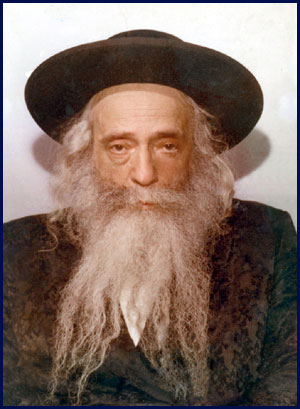Historical Perspective
The darkest period in the history of the Jewish People.
More than 12,000 Jews were gassed every day in Auschwitz’s gas chambers; executed with utmost German precision and sophistication. Amongst them were the wife and 11 children of Rabbi Yekutiel Yehuda Halberstam, scion of the famous Sanz Rabbinic Dynasty.
In June 1944, 10,000 inmates, including the 39 year old Rabbi Halberstam, were transferred from their camp to Warsaw. There they were ordered to dismantle what was left of the burned out buildings of the Warsaw Ghetto and load the debris on to waiting trucks that would take them to Germany.
By the end of July, the 2,000 inmates who had survived the Nazi brutality were ordered on a march to the infamous Dachau Death Camp in the German heartland. The tormented frail inmates were forced to walk 20 kilometers a day under the torturous August sun. Those who could not maintain the pace were instantly shot by the drawn rifles of the bloodthirsty S.S. Guards..
Rabbi Halberstam was shot in the shoulder and a lost considerable amount of blood, but seeking medical help was out of the question. As he was losing his strength he made a vow to the Almighty G-d: “If I merit to survive I will garner all my energies to build a hospital in the Holy Land where every human being will receive the same dedicated medical care irrespective of nationality or creed.” As the Rabbi uttered these astonishing words, he noticed a tree with luscious green leaves along the road within reach of the marching inmates. The Rabbi tore off a large leaf and with his last ounce of strength managed to place it on his wound. The bleeding stopped and the Rabbi survived.
Yom Kippur 1945
Upon conducting his first inspection of the Displaced Persons Camps in the U.S. Zone of occupied Germany, General Dwight D. Eisenhower stumbled upon the makeshift Synagogue in Feldanfing (near Munich) where survivors were assembled for Yom Kippur services. General Eisenhower was greeted by Rabbi Halberstam, who represented the thousands of survivors. Eisenhower inquired about the conditions in the D.P. Camps, wanting to hear the concerns of the survivors. So impressed was the General by the intelligence, selflessness and strength of spirit of this physically destitute Rabbi that he decided to ask him for a personal blessing.
Years later, at a Benefit Reception for Sanz Medical Center/Laniado Hospital, Ambassador Maxwell Rabb, Cabinet Secretary and close confidant of President Eisenhower, revealed that Eisenhower had mentioned to him on several occasions the blessing he had received from a Jewish Rabbi in the D.P. after the end of the war. The President recalled the Rabbi’s assurance, “that in merit of his leading role in liberating the Jewish People from the most evil power in the history of mankind, the Almighty will bless him to ascend to the highest leadership position in the Free World”.
November 1954
The fledgling Jewish State was struggling enormously with the dual responsibility of absorbing hundreds of thousands of new immigrants driven from North African countries and building up a strong security structure. Israel’s Arab neighbors headed by Egypt were seeking every opportunity to undermine the existence of the Jewish State. Armed Fedayeen terror groups infiltrated Israel from Jordan and Egypt to kill as many Jews as possible. Morale in the country was ebbing dramatically.
Rabbi Halberstam instinctively sprung into action. Imbued with fierce “ahavat yisrael” (love of the Jewish People) and an unwavering belief in Jewish eternity he traveled the length and breadth of the country for 10 full weeks. With his indomitable faith he radiated inspiration and encouragement into the hearts of thousands of weary Israelis. He met with David Ben-Gurion, Levi Eshkol and Moshe Dayan and assured everyone of his resolve to bring tens of thousands of Jews from the USA and other Western countries to the Holy Land.
November 1956
When the Sinai Campaign – provoked by Egypt’s blockade of the Port of Eilat – was launched, the dynamic community of Kiryat Sanz in northern Netanya was already well established. The first multiple dwellings were already standing and inhabited. Construction of a flourishing diamond factory built by one of New York’s leading diamond merchants was progressing rapidly. A brick factory to produce building blocks necessary for the ongoing construction was established. Educational facilities for children and a Community Center for adults were built. Thus the remarkable enterprise of Kiryat Sanz became a reality and a significant milestone in the history of Aliyah (=immigration) to Israel from Western Countries has been reached.
Fulfilling His Vow
Realizing that the fast-growing City of Netanya was still without a hospital, Rabbi Halberstam resolved that the time had now come to uphold the vow he made during the fateful march from Warsaw to Dachau in August 1944. He dedicated a prime plot of land on the northern edge of Kiryat Sanz, commissioned architectural plans and in 1958 the cornerstone was laid for a modern general hospital. The hospital would include all basic medical departments and ancillary services required for a municipal hospital.
Recognizing that no source of continuous funding was available for the project’s construction Rabbi Halberstam decided to build the hospital “brick by brick” depending on the availability of funds that he would be able to raise. Consequently, construction of the hospital building progressed at a very slow pace. Nevertheless, the Rabbi was determined to proceed with this vital project despite the difficulties. After years of determined effort and overcoming insurmountable hardships, the hospital was opened on June 21, 1976.
